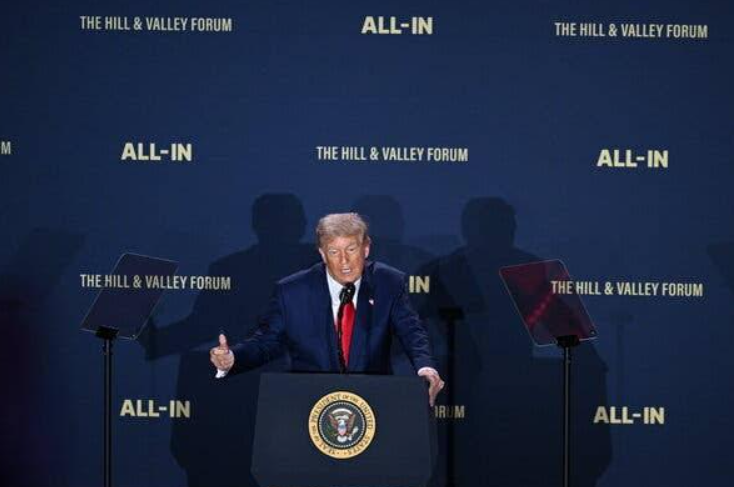Past President Donald Trump has launched a new ambitious agenda, an “AI Action Plan,” to lead America to global leadership in artificial intelligence. Ranging from inclusive infrastructure development, deregulatory hurdles, to stimulating foreign technology overseas, the plan is unprecedented in comparison to past administrations’ policy.
Initiated in reaction to China’s move of removing its policy of accelerating towards America and shifting America’s position in the technology digital age, the plan is the new ambitious page of the new AI weapons of competition.
President Trump just declared war on every AI regime.
His $500 billion America’s AI Action Plan changes everything…
And he now has the ONE thing China and Europe desperately need but can’t replicate.
Here’s how Trump is outplaying the entire global AI race:
A Thread pic.twitter.com/Dox2vuVH0n
— Karl Mehta (@karlmehta) July 24, 2025
Aims Action Plan Pillars
The plan has three pillars: accelerating the development of AI infrastructure with urgency, boosting U.S. AI exports, and pushing back against state-owned AI tools.
- Accelerating Data Centres
To accelerate the creation of AI, Trump budget requests feature reducing regulatory barriers to building data centers. Skirting as quickly as possible standard environmental review and local zoning approvals, the administration would proceed more rapidly with buildout of high-performance computing facilities.
The critics bemoan that deregulation has a price tag, that is, when extracting fossil fuels to entice historic levels of energy use. Corporate CEOs, on the other hand, welcomed speedy project approval and investment.
- U.S. Growth in AI Exports
Part of the larger piece of the plan is to make America the world’s leading exporter of AI technology. That is, sell AI models, software, and hardware, mainly to allies.
Washington is also looking to gain not just economic rewards but also greater leverage in shaping the world’s AI standards and norms. The move is pragmatic in the wake of previous efforts at gaining foreign digital allies that are being looked at again under a new master plan that carries an ambitious tone.
- Posturing Ideological Neutrality
More contentious among the provisions of the plan is the provision requiring federally developed AI software to be “ideologically neutral.” The Trump administration is trying this as a means of ensuring that government-hired AI systems won’t be biased and won’t have so-called “woke programming.”
Where backers support this as a clarion call in the cause of objectivity, their critics have this to say: “Ideological neutrality” is more a myth and can be used to censor varied sets of views in developing algorithms.

Trump’s Vision for U.S. AI Dominance ( Image Source: The New York Times )
Why This Policy Matters Now
It stands in opposition to administration AI policy implementation on the platform of wise innovation and responsible AI deployment. Trump policy places all its eggs into the deregulation and speed basket, hoping that a let-it-rip policy by an administration will create growth.
With these massive investments in artificial intelligence research and talent, this strategy places the U.S. firmly on record for not being intimidated to stand and be counted in defending national competitiveness and interest in response to glacial consensus-based policy-making.
Implications Across Sectors
Energy and Infrastructure
Expansion of data-centres at this extent will require titanic levels of power. Developers, grid operators, and utilities already are anticipating the burden. Environmental costs most likely will be significant unless cleaner technology comes into consideration.
Technology and Semiconductors
The chip makers and the hardware companies would be allowed to account for more-than-previously exports of products as well as investment in infrastructural growth. The policy would witness the entry of a new growth period for the mid-sized firms of AI value chains.
Diplomacy and Defence
This vision places AI, not as a market good but a strategic good. Whereas the United States is building up its export of AI, it is not only increasing its leverage in allied countries but also creating a tech-facing front line for America’s geo-political battle with China.
Expert Reactions
Policy geeks graded the AI Action Plan mixed. Graham Brookie of the Atlantic Council appreciated the vision in the plan but was not sure federal agencies would be able to do the vision in the plan, foreign policy and infrastructure coordination specifically.
The greenies worried that if building codes were eased, environmental practice would be done in second place, particularly if contractors would rather construct on fossil fuel than green building.
Others worried that the ambiguity of the requirement of neutrality would be exploited to shut off debate or constrain creativity.
What’s Next?
Watch for:
- Congressional approval: Will Congress enact national standards or allow states to follow each other to enact them?
- Environmental policy: Will AI infrastructure gains be met with pledges of clean energy?
- Global reachability: How fast can U.S. companies export AI goods globally, and what would China or the EU do?
What It Means to Americans
Investors are provided with the promise of future expansion in AI infrastructure, energy, and semiconductor markets by the strategy. Future transaction-making on hardware exports and future data center build-out can rely on early leaders.
Liberalized export controls and deregulated control create new markets and sources of innovation for technology companies.
To cities, it is irrelevant. New information centers bring jobs to the host town but tax energy grids and punch up the earth, particularly to third-world or rural nations.
Final Thoughts
Trump’s AI Action Plan is not policy reform, it’s a mission statement. It’s a vision in which America becomes successful, not through limitation or domination but through unceasing expansion, smart exports, and an iron fist of resolve on narrative.
Whether that path is a renaissance facilitated by technology or brings new ethical and environmental problems is in the eye of the beholder. What it is, however, one thing is certain, nonetheless: hysterical zeal to learn and teach AI has reached a tipping point, cut from hope, desire, and will to survive.

